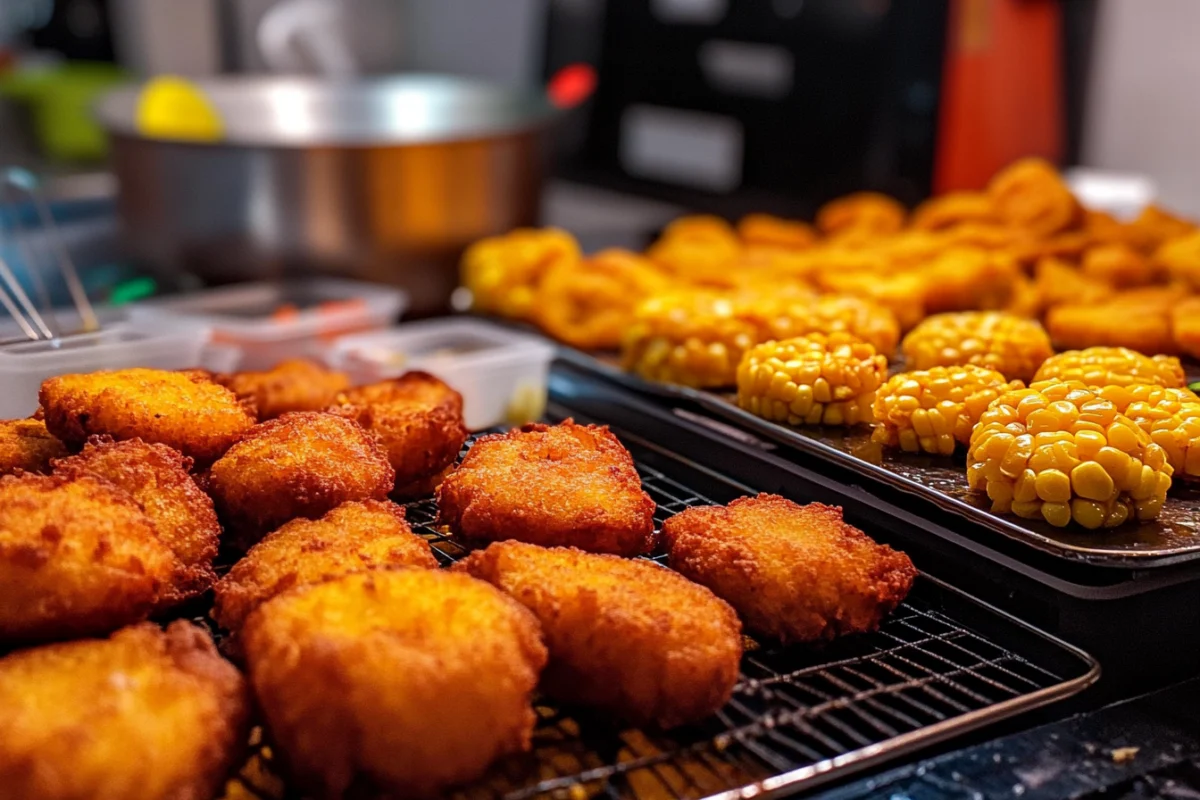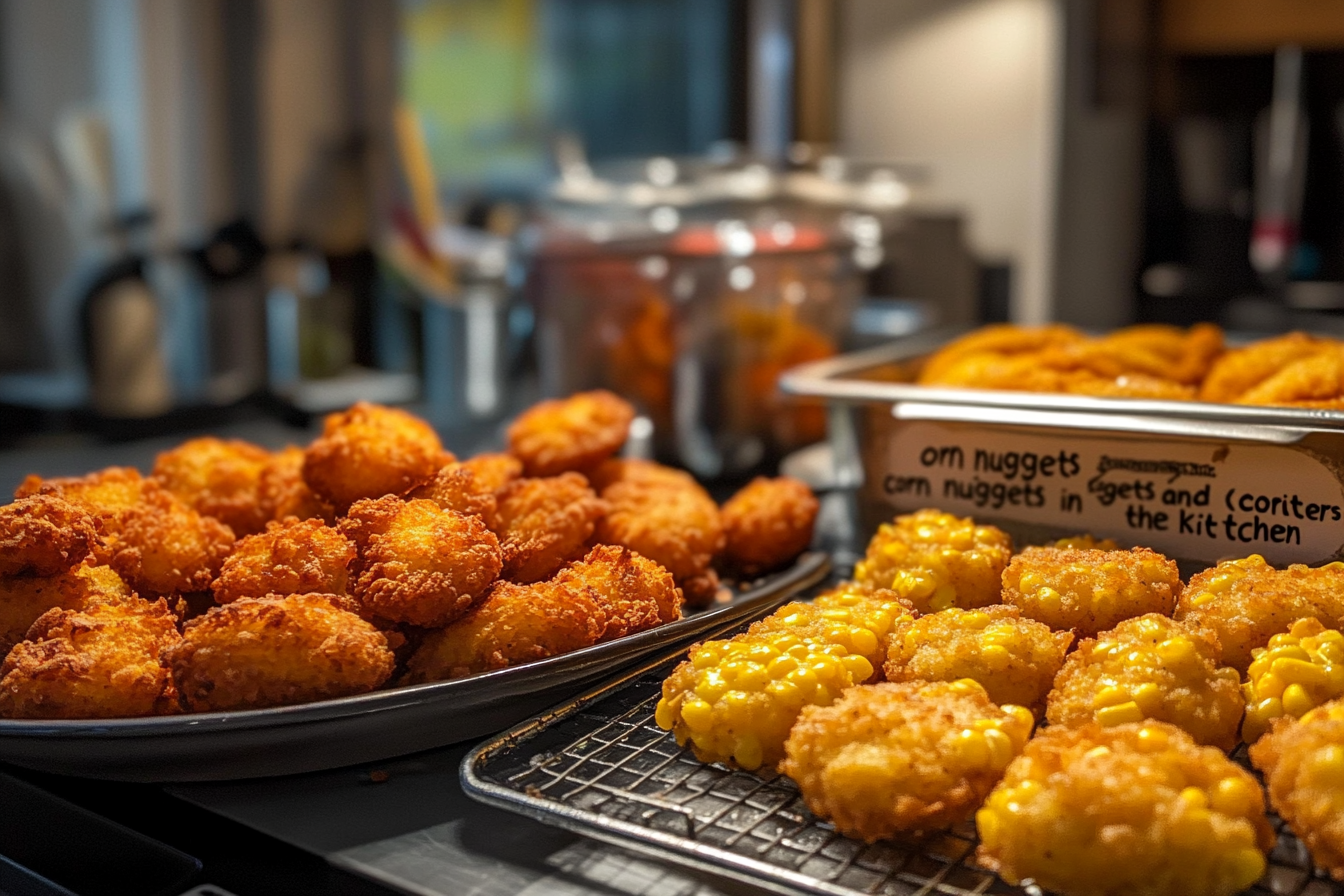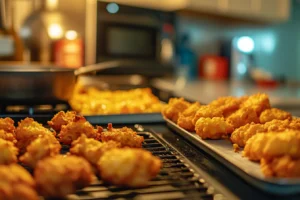Introduction and Basic Differences
Corn-based snacks have long been a favorite in many cultures around the world, especially in the Southern United States. Two of the most popular types are corn fritters and corn nuggets. Though these two treats share a few similarities, they are distinct in terms of ingredients, shape, texture, and preparation methods.
- Corn fritters are crispy on the outside, with a light and airy texture inside. They often contain whole corn kernels or sometimes creamed corn.
- Corn nuggets, on the other hand, are typically smaller, bite-sized pieces filled with a cornmeal batter and sometimes creamed corn for added moisture and flavor.
In this article, we will dive deep into these two delicious dishes, uncovering their origins, ingredients, preparation methods, and key differences to help you understand what makes each dish unique.
If you’re interested in exploring different ways to prepare corn-based recipes, check out this Corn Nuggets Guide: Recipes, Variations, and Benefits, which dives deeper into the versatility of corn-based dishes.
What Are Corn Fritters?
Corn fritters are savory cakes made from a batter or dough that prominently features corn. Originating from Native American cuisine, these fried treats have become a staple in various regions, particularly in the United States.
Key Characteristics:
- Batter-based: Unlike corn nuggets, fritters are made with a lighter batter, often combined with flour, eggs, milk, and corn kernels.
- Shape: Corn fritters are typically flat, round, or sometimes slightly oval-shaped. They are fried in hot oil until golden and crispy.
- Texture: They are light and airy on the inside, with a crunchy exterior, offering a delightful contrast.
- Serving style: Corn fritters are often served as appetizers, side dishes, or snacks. They can be enjoyed with a variety of dipping sauces, such as sour cream, honey, or spicy mayonnaise.
Variations in Corn Fritters:
- Sweet or savory: Some corn fritter recipes lean toward the sweet side, using sugar or sweet corn for a dessert-like version.
- Regional variations: In the Southern U.S., corn fritters might be seasoned with cayenne pepper or jalapeños, while Midwestern versions often keep it simple with just salt and pepper.
What Are Corn Nuggets?
Corn nuggets are similar to corn fritters but are made into small, bite-sized nuggets. These crispy delights are often served as finger food and are popular at fairs, carnivals, and as appetizers in Southern cuisine.
If you want to try making corn nuggets at home, this Corn Nuggets Recipe is a great place to start. You’ll learn how to make them from scratch and add your own twist.
Key Characteristics:
- Breading vs. batter: Unlike the lighter batter used in corn fritters, corn nuggets are typically coated in a cornmeal-based breading, giving them a denser and crispier exterior.
- Shape: Corn nuggets are small, round, or cube-like pieces, much smaller than the flat, round shape of fritters.
- Creamed corn filling: Some recipes use creamed corn inside the nugget, contributing to a soft and moist texture that contrasts with the crunchy outer layer.
- Fried to perfection: Like fritters, corn nuggets are deep-fried to a golden brown, creating a crispy exterior while keeping the inside moist and flavorful.
Popular Recipes and Uses:
- Appetizers: Corn nuggets are often served as a snack or appetizer at parties and gatherings.
- Dipping sauces: They pair well with ranch dressing, barbecue sauce, or sweet chili sauce.
Ingredients, Cooking Techniques, and Variations
Corn Fritter Ingredients
To make the perfect corn fritters, you need a few basic ingredients that come together to create a crispy, flavorful treat. Here’s what you’ll typically need:
- Corn kernels: Fresh, frozen, or canned. These form the core of the fritter and give it that signature corn flavor.
- Flour: Provides the structure for the batter and helps achieve a light texture.
- Eggs: Bind the ingredients together and add moisture to the batter.
- Milk or buttermilk: Adds a rich, creamy texture to the batter, making it easy to fry.
- Baking powder: Helps the fritters rise, creating a light and airy interior.
- Seasonings: Salt, pepper, and sometimes spices like paprika or cayenne pepper for extra flavor.
Variations:
- Sweet corn fritters: Some recipes use sugar or honey for a sweetened version of this dish, especially in dessert-style fritters.
- Vegetarian: For a vegetarian version, you can use plant-based milk or gluten-free flour to cater to dietary restrictions.
Corn Nugget Ingredients
The ingredients for corn nuggets are similar to those of corn fritters but with a few key differences, particularly in the coating and filling.
- Cornmeal: This is the primary ingredient for the breading, giving the nuggets their crunchy, golden exterior.
- Corn kernels: You can use either whole corn kernels or creamed corn inside the nuggets. Creamed corn offers a moist, soft filling that contrasts with the crispy outer layer.
- Flour: Used in combination with cornmeal to help the nuggets hold their shape during frying.
- Eggs and milk: These ingredients help bind the mixture together and ensure the nuggets remain crispy.
- Baking powder: Just like in corn fritters, this helps the nuggets puff up slightly during frying.
Variations:
- Cheese-filled corn nuggets: Some recipes add cheese, such as cheddar, to the batter for a savory twist.
- Spicy corn nuggets: For those who enjoy a bit of heat, you can add jalapeños, hot sauce, or cayenne pepper to the batter for an extra kick.
The Cooking Process: Corn Fritters
Making corn fritters is relatively simple, but it requires attention to detail for the perfect texture. Here’s a step-by-step guide:
- Prepare the ingredients: In a large bowl, mix the corn, flour, eggs, milk, baking powder, and seasonings until you get a smooth batter.
- Heat the oil: Heat oil in a deep fryer or a large skillet over medium heat.
- Fry the fritters: Drop spoonfuls of the batter into the hot oil. Fry until golden brown and crispy on both sides, about 3-4 minutes per side.
- Drain excess oil: Remove the fritters from the oil and place them on a paper towel to drain excess oil.
Tips for Perfect Corn Fritters:
- Ensure the oil is at the right temperature to avoid soggy fritters.
- Use a slotted spoon to turn the fritters for an even golden color.
- Don’t overcrowd the frying pan, as this will cause the fritters to become oily.
The Cooking Process: Corn Nuggets
The cooking process for corn nuggets involves coating the corn mixture in a cornmeal breading and frying until golden and crispy.
- Prepare the corn mixture: Mix the corn kernels (or creamed corn), flour, eggs, milk, baking powder, and seasonings in a bowl.
- Form the nuggets: Scoop the mixture into small bite-sized portions, shaping them into small balls or nuggets.
- Coat with cornmeal: Roll each nugget in cornmeal to give it a crispy outer layer.
- Fry the nuggets: Deep fry the corn nuggets in hot oil until golden brown, about 3-4 minutes.
- Drain excess oil: Remove the nuggets from the oil and place them on paper towels to absorb excess oil.
Tips for Perfect Corn Nuggets:
- Ensure the oil temperature is consistent for even frying.
- For extra crispiness, double coat the nuggets in cornmeal before frying.
- Serve immediately while hot for the best texture.
Key Differences Between Corn Fritters and Corn Nuggets
Texture Comparison: Corn Fritters vs Corn Nuggets
One of the most notable differences between corn fritters and corn nuggets is their texture. Although both dishes are fried, their texture differs due to the distinct ingredients and preparation methods used.
- Corn Fritters: These tend to be light, airy, and soft on the inside, thanks to the batter that binds the corn kernels. The batter is typically thinner, allowing the fritters to puff up slightly when fried. The exterior is crispy, but the interior remains moist and tender.Key Features:
- Light, airy texture inside.
- Crispy outer coating.
- Soft and moist due to batter and corn kernels.
- Corn Nuggets: The texture of corn nuggets is generally denser and crunchier due to the cornmeal breading. The small size of the nuggets allows them to crisp up more uniformly, resulting in a crunchier outer layer. The inside is slightly softer, especially if creamed corn is used, but it still maintains a firmer, more compact texture than fritters.Key Features:
- Dense, crunchy texture.
- Crisp exterior with a firmer interior.
- Soft filling if creamed corn is included.
Both dishes are crispy, but corn nuggets are typically crunchier and denser, while corn fritters offer a fluffier, more delicate bite.
Flavor Differences: Corn Fritters vs Corn Nuggets
While both corn fritters and corn nuggets are made primarily from corn, the flavor profiles of these two snacks differ based on their ingredients and preparation.
- Corn Fritters: These have a mild, slightly sweet flavor from the corn kernels combined with the richness of eggs and milk in the batter. The flavor can be enhanced with seasonings like paprika, garlic powder, or onion powder, but the overall taste remains subtle and balanced. Sweet corn fritters may also have a hint of sugar, making them a sweet treat rather than a savory snack.Key Features:
- Mild, slightly sweet flavor from corn.
- Savory or sweet variations depending on recipe.
- Can be spiced with seasonings like paprika, garlic, or onion powder.
- Corn Nuggets: Corn nuggets, thanks to the cornmeal coating, have a slightly earthy flavor that complements the sweet corn inside. The breading adds a bit of saltiness, especially when fried to a crispy golden brown. The flavor is typically more intense than that of corn fritters, as the breading often absorbs some of the oil from frying, adding richness to the overall taste.Key Features:
- Earthy flavor due to cornmeal.
- Rich, slightly salty taste from the fried breading.
- Sweet corn flavor inside, enhanced by creaminess from creamed corn.
Ultimately, corn fritters offer a lighter, sweeter flavor, while corn nuggets are heartier, with a more substantial, savory profile.
Size and Serving Style
The size and serving style of corn fritters and corn nuggets also contribute to their differences.
- Corn Fritters: These are usually larger in size, often the size of a small pancake or a small patty. They can be served in varying quantities depending on the occasion, typically as appetizers or side dishes. Corn fritters are usually eaten with forks and knives, especially when they are served as part of a larger meal.Serving Style:
- Larger portions, often round or oval-shaped.
- Served with dipping sauces like sour cream, honey, or spicy mayo.
- Ideal for formal meals or casual gatherings.
- Corn Nuggets: In contrast, corn nuggets are smaller, bite-sized snacks. They are typically served as finger food at fairs, parties, or as appetizers. Because of their size, they are perfect for dipping into sauces, and they are often paired with condiments like ranch dressing, barbecue sauce, or spicy ketchup.Serving Style:
- Small, bite-sized pieces, often round or cube-shaped.
- Perfect for finger food or quick snacking.
- Commonly served with dipping sauces like ranch, barbecue, or sweet chili.
The difference in size affects how these dishes are served, with corn fritters usually being part of a meal, while corn nuggets are often enjoyed as snacks or appetizers.
Health Considerations and Nutritional Value
Nutritional Breakdown of Corn Fritters
When considering corn fritters, it’s important to understand the nutritional value to make informed choices about their consumption. Although they can be a delicious treat, they should be eaten in moderation due to their fried nature.
- Calories: A typical serving of corn fritters (about 2-3 fritters) contains around 150–250 calories, depending on the size and ingredients.
- Fat Content: Corn fritters are fried, so they can have a relatively high fat content. A serving can contain anywhere from 8-15 grams of fat, depending on the amount of oil used in frying.
- Carbohydrates: A serving of corn fritters generally has around 20-30 grams of carbohydrates, primarily from the corn and flour used in the batter.
- Protein: Since corn fritters contain eggs and corn, they can provide a modest amount of protein, typically around 3-5 grams per serving.
- Vitamins and Minerals: Corn fritters can be a good source of Vitamin A and Vitamin C (from the corn), as well as small amounts of iron and calcium.
Health Considerations:
- Frying adds calories: While the corn provides some essential nutrients, the frying process adds extra calories and fat.
- Can be made healthier: To make fritters healthier, you can opt for baking them instead of frying, and use whole grain flour or reduce the oil for a lighter version.
Nutritional Breakdown of Corn Nuggets
Corn nuggets have a similar nutritional profile to corn fritters, but the cornmeal breading and smaller size of the nuggets lead to some key differences.
- Calories: A serving of corn nuggets (usually around 4-6 pieces) can contain approximately 200-300 calories.
- Fat Content: Due to the cornmeal coating and deep-frying process, corn nuggets can have a fat content ranging from 10-18 grams per serving.
- Carbohydrates: Corn nuggets tend to be a bit higher in carbs due to the cornmeal used for breading. A serving generally has around 25-35 grams of carbohydrates.
- Protein: The protein content is similar to that of corn fritters, usually around 3-5 grams per serving.
- Vitamins and Minerals: Like corn fritters, corn nuggets are a good source of Vitamin A, Vitamin C, and iron, but the higher fat content may reduce their overall health benefits.
Health Considerations:
- Higher in fat: Because of the breading and frying process, corn nuggets are generally higher in fat and calories compared to corn fritters.
- Can be made healthier: A healthier version of corn nuggets can be made by using baked cornmeal breading or air frying to reduce the amount of fat and calories.
Frequently Asked Questions (FAQ)
1. What is the main difference between corn fritters and corn nuggets?
- Corn fritters are typically made with a batter and are light and airy, while corn nuggets are breaded and fried, resulting in a denser and crunchier texture.
2. Are corn fritters and corn nuggets healthy?
- Both are fried foods, which can be high in calories and fat. However, healthier versions can be made by baking or air frying and using whole-grain flour or reducing oil.
3. Can I make corn fritters or corn nuggets without eggs?
- Yes! For a vegan or egg-free version, use a flax egg or another egg substitute like applesauce.
4. Can I make corn fritters or corn nuggets ahead of time?
- Yes! Both can be made in advance and stored in the fridge for a few days. Reheat in the oven or air fryer for the best texture.
5. What’s the best way to serve corn fritters and corn nuggets?
- Both are great as appetizers, snacks, or side dishes. They pair well with dipping sauces like ranch, barbecue, or spicy mayo.
Conclusion
In conclusion, corn fritters and corn nuggets are both delicious fried treats that showcase the versatility of corn in cooking. The primary difference lies in their texture and preparation corn fritters are light and fluffy, while corn nuggets are dense and crunchy. Whether you prefer a sweet or savory snack, both options can be customized to suit your taste. Though both are typically fried, healthier versions can be made by opting for baking or air frying. Regardless of the method, both are sure to be a hit at your next meal or gathering!



